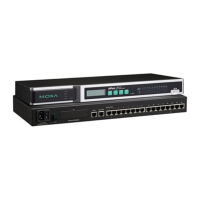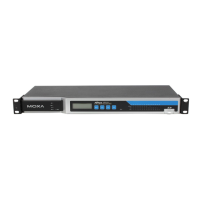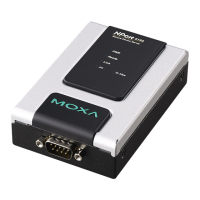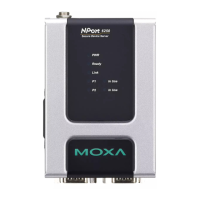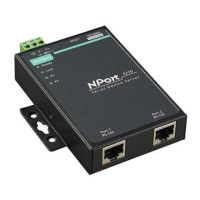NPort 6000 Series Configuring Serial Port Operation Modes
ATS0≧1: The NPort 6000 will accept the TCP connection immediately and then send the “CONNECT baud”
command to the serial port, in which baud represents the baudrate of the NPort 6000’s serial port. After that,
the NPort 6000 immediately enters data mode.
Dial-out
The NPort 6000 accepts the AT command “ATD IP:TCP port” from the serial port and then requests a TCP
connection from the remote Ethernet Modem or PC. Here IP is the IP address of the remote Ethernet modem
or PC, and TCP port is the TCP port number of the remote Ethernet modem or PC. Once the remote unit accepts
this TCP connection, the NPort 6000 will send out the CONNECT baud” signal via the serial port and then enter
data mode.
Disconnection request from local site
When the NPort 6000 is in data mode, the user can initiate disconnection by sending “+++” from the local
serial port to the NPort 6000. Some applications allow you to directly set the DTR signal to off, which will also
initiate disconnection. The NPort 6000 will enter command mode, and after 1 second, you can then enter “ATH”
to shut down the TCP connection The NPort 600 0 will return a “NO CARRIER” via the serial port.
The “+++” command cannot be divided. The “+” character can be changed in register S2, and the guard time,
which prefixes and suffixes the “+++” in order to protect the raw data, can be changed in register S12.
Disconnection request from remote site
After the TCP connection has been shut down by the remote Ethernet modem or PC, the NPort 6000 will send
the “NO CARRIER” signal via the serial port and then return to command mode.
AT Commands
The NPort 6000 supports the following common AT commands as used with a typical modem:
No. AT command Description Remarks
1 ATA Answer manually
2 ATD <IP>:<Port> Dial up the IP address : Port No.
3 ATE ATE0=Echo OFF
4 ATH ATH0=On-hook (default)
ATH1=Off-hook
5 ATI, ATI0, ATI1, ATI2 Modem version reply “OK” only
6 ATL Speaker volume option reply “OK” only
8 ATO On line command
9 ATP, ATT Set Pulse/Tone Dialing mode reply “OK” only
10 ATQ0, ATQ1 Quiet command (default=ATQ0)
11 ATSr=n Change the contents of S register See “S registers”
12 ATSr? Read the contents of S register See “S registers”
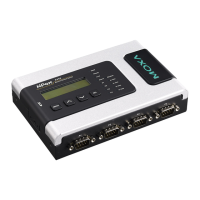
